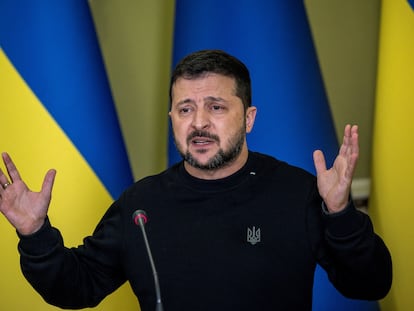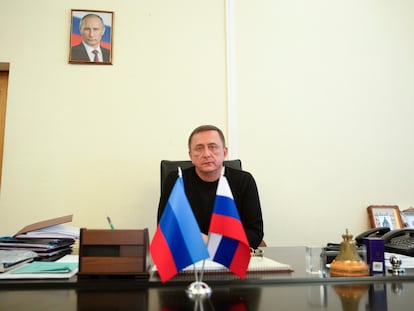Under siege on the Ukrainian front line of Avdiivka: ‘Russians are more prepared for war, and to die’
Moscow’s air and artillery superiority is pushing the defenders of the strategic city in Donetsk province to the limit as ammunition supplies run low


Day breaks under the cover of fog in Ocheretyne, offering the best protection against Russian air dominance. The Ukrainian self-propelled artillery takes the opportunity to unload a hail of shells on the enemy in a barrage lasting about 20 minutes, until the sky begins to clear over this village on the Avdiivka front, in the east of the country. The skies are controlled at all times by Russian drones. Ukrainian artillery operations are kept short to avoid their positions being identified. Last Friday morning, Ukrainian guns were aimed at the most decisive sector of the battle, just under four miles away: the railway tracks connecting Avdiivka with unoccupied Ukraine.
Ivan plucks a few blades of dry grass and uses them to reproduce a map of the area where his men are fighting. Like all the soldiers interviewed for this article, he prefers not to give his full name. His role is to coordinate assault companies of the 47th Mechanized Brigade, one of the Ukrainian units set up with NATO weapons and training. A civil engineer by profession, Ivan spent a year in training before joining the war, including four months in Germany and Lithuania. His men are defending the railroad tracks on the northern flank of Avdiivka: the rail line is elevated, serving as a retaining wall against advancing armor, and from it infantry movement can also be slowed. “If the Russians take control of the tracks, it will be a disaster,” Ivan says. Before the war, Avdiivka had more than 30,000 inhabitants. Now there are fewer than 2,000.
By disaster, this officer means that the Russians, by dominating the roads, can ensure the advance of their troops to surround Avdiivka from the north. The Russian assault is focused on the vicinity of the city’s coke factory, the largest production plant for this kind of fuel in Europe. The problem is that the enemy has already punched through on a two-mile stretch of the railway line. “They don’t have control; in a single day we can take and lose positions there three times. We are fighting at 30 meters,” explains Ivan. “They keep coming, in platoons of 10 to 15 men. They are constantly attacking us.” Russian casualties are innumerable, says Ivan, but on the Ukrainian side they are also very high: he himself has lost his entire platoon of 17 men, either dead or captured.
The bulk of the 47th Mechanized Brigade was transferred to Avdiivka in mid-October, when the current Russian offensive to take the city began. Ivan and his men had earlier participated in the failed Ukrainian summer counteroffensive on the Zaporizhzhia front. The 47th Brigade suffered heavily in the first three months of the counteroffensive, when Kyiv opted for a strategy of assaults with large armored columns. Russian minefields and fortified defenses slowed the advance, and enemy artillery and drone bombs easily destroyed vehicles and troops.
Military sources on the Zaporizhzhia front assured this newspaper last September that the 47th Brigade lost more than 30% of its strength in that battle: around 2,000 of its 5,000 soldiers. Ivan claims he saw 16 of his comrades die. “But it’s worse emotionally in Avdiivka,” he adds, “because defending is harder on morale than attacking. You have to pray, sheltered in the trench for four days, the time the rotations last, that their artillery doesn’t kill you, and then resist assault after assault by their infantry.”
Russian casualties in the siege of Avdiivka are counted in hundreds of armored vehicles and thousands of human lives. Ukrainian military propaganda accounts on social networks have shared numerous videos of the destruction caused to the invading forces, especially by the cluster munitions provided by the United States. But Ivan shakes his head in disapproval: apart from the training of their troops, he says, the Russians are superior in every way, and they have resources to spare. “If they take the railroad tracks, they will send the armor again, and if 10 vehicles come out from their second line, our artillery will hit them, yes, but four will get through and reach their destination.”
Ivan underlines the main difference between the Ukrainian and Russian armies in Zaporizhzhia: his squadron surrounded a Russian position defended by professional soldiers from an airborne division. The opposing force eventually ran out of ammunition and were repeatedly urged to surrender, according to his account. The enemy blew themselves up with grenades instead: “I don’t know any Ukrainians who have done this. They have a different conception of life: Russians are more prepared for war, and to die.” His words coincide with statements made to The Economist by Valerii Zaluzhnyi, the commander-in-chief of the Ukrainian Armed Forces. His biggest mistake, Zaluzhnyi admitted, was to believe that the 150,000 Russian soldiers killed in Ukraine, by his count, would be enough for the Kremlin to stop the war.
“Like zombies”
The fog recedes in Ocheretyne and nerves spread among the soldiers of the 110th Separate Mechanized Brigade. The troops take cover in underground shelters and pick-up vehicles with large-caliber machine guns are positioned among the trees to shoot down the soon-to-arrive drones. Seth, the code name of an infantry company commander, corroborates what experts and other officers consulted on the Avdiivka front indicate: one of the biggest changes in the war has been Moscow’s leap forward in drone technology and production. Russian air superiority over the defending army is overwhelming, military officers like Seth say. The most cited models are the same: Orlan reconnaissance drones observe everything from three kilometers (1.8 miles) above the ground; they identify a target and within minutes Lancet bomb drones arrive. Seth also stresses that they have seen an increase in enemy Zoopark radars, which detect the coordinates of artillery positions from their sound waves.
Seth refers to the Russian infantry as “zombies” because they advance even in the face of almost certain death. As far as he has been able to ascertain, enemy troops do not retreat on pain of being executed by order of their superiors. U.S. intelligence services stated in October that they are certain the orders of the Russian high command are to shoot soldiers who retreat during an attack.
“It’s like in Bakhmut, they are advancing madly, like zombies, because they want to take Avdiivka, whatever it takes,” says Alexander, commander of a unit operating a U.S. Paladin howitzer in the 47th Brigade. As in Bakhmut, he points out, there have been days in Avdiivka when there have been up to 300 drones in the sky. The difference is that his Paladin does not have enough ammunition: if in Bakhmut in April, and in summer in Orikhiv on the Zaporizhzhia front, his unit fired between 100 and 150 shells a day, in Avdiivka they are only able to fire 15. According to the military veteran, the guns also lose accuracy from being used so much. In summer, his Paladin had a margin of error of seven meters over the target; now it is 70 meters.
Lack of ammunition
The lack of ammunition for Ukrainian artillery has been confirmed by Volodymyr Zelenskiy’s government and by Zaluzhnyi, who in an essay published by The Economist estimated that his troops would not have a sufficient stockpile to return to the attack for at least a year. Kyiv’s NATO allies have practically run out of munition reserves and the Western military industry will not be able to fully arm their own countries and Ukraine until the end of 2024, according to the estimates of Zaluzhnyi and U.S. and European defense analysis centers.
This shortfall also explains one of Russia’s biggest advantages in the war, says Roman, commander of a mortar unit in the Ukrainian 110th Separate Brigade: its trenches. “The Russians are way ahead of us in trench engineering,” says Ivan, who agrees with other military personnel consulted this fall on the various fronts in Donetsk: “The Russians advance 300 or 500 meters and dig, advance 300 meters and dig and dig again. Their trenches are deeper and more secure than ours. They gain ground and secure it. When we take one of their positions, we are happy, because we are more secure [in their trenches] than in ours.”
Roman points out that the Russian ability to dig trenches is due to not having sufficient ammunition to prevent it. According to his calculations, if at the beginning of the war his mortars could fire one shell for every three enemy shells, now the difference is one to eight. “We can’t operate for long either because of the constant air strikes,” adds the officer.
Zaluzhnyi detailed in his report for The Economist that the conflict had entered a new phase, that of positional warfare, in which grand maneuvers and rapid advances are no longer feasible. Now deterrent fire and infantry assaults on specific positions predominate. To this end, the commander-in-chief of the Ukrainian Armed Forces asked Kyiv’s international allies for the most advanced technology to take control of the air, with drones and electromagnetic wave weapons to counter the enemy’s unmanned vehicles. Zaluzhnyi’s appraisal that the front has stagnated was denied by Zelenskiy, but it was a jolt of pessimism for the Ukrainian population and the international community. For the soldiers at the front, however, Ivan says: “Nothing he said was new to us. It was a message to our partners abroad, to warn that this is the situation.”
Sign up for our weekly newsletter to get more English-language news coverage from EL PAÍS USA Edition
Tu suscripción se está usando en otro dispositivo
¿Quieres añadir otro usuario a tu suscripción?
Si continúas leyendo en este dispositivo, no se podrá leer en el otro.
FlechaTu suscripción se está usando en otro dispositivo y solo puedes acceder a EL PAÍS desde un dispositivo a la vez.
Si quieres compartir tu cuenta, cambia tu suscripción a la modalidad Premium, así podrás añadir otro usuario. Cada uno accederá con su propia cuenta de email, lo que os permitirá personalizar vuestra experiencia en EL PAÍS.
¿Tienes una suscripción de empresa? Accede aquí para contratar más cuentas.
En el caso de no saber quién está usando tu cuenta, te recomendamos cambiar tu contraseña aquí.
Si decides continuar compartiendo tu cuenta, este mensaje se mostrará en tu dispositivo y en el de la otra persona que está usando tu cuenta de forma indefinida, afectando a tu experiencia de lectura. Puedes consultar aquí los términos y condiciones de la suscripción digital.
More information
Archived In
Últimas noticias
Most viewed
- Sinaloa Cartel war is taking its toll on Los Chapitos
- Oona Chaplin: ‘I told James Cameron that I was living in a treehouse and starting a permaculture project with a friend’
- Reinhard Genzel, Nobel laureate in physics: ‘One-minute videos will never give you the truth’
- Why the price of coffee has skyrocketed: from Brazilian plantations to specialty coffee houses
- Silver prices are going crazy: This is what’s fueling the rally










































